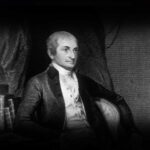John Jay was born on December 12, 1745. He served as the country’s first Chief Justice and was one of the founding fathers of the United States. He was a devoted patriot. He dabbled in politics as well and went to the First Continental Congress. Even though he was first dubious about America breaking away from Britain, he aggressively opposed British control after the American Revolution began. He also rose to prominence as a dedicated advocate for the abolition of slavery. Let’s toast to his life today.
Fast Facts
Full Name:
John Jay
Nickname:
The Chief Justice, The Founding Father, The Federalist
Birth date:
December 12, 1745
Death date:
May 17, 1829 (age 83)
Zodiac Sign:
Sagittarius
Background
Peter Jay and Mary Van Cortlandt welcomed John Jay into the world on December 12, 1745, in New York City, New York, British America. Up to the age of eight, he received his education from his mother and moved to New Rochelle to learn under an Anglican priest, Pierre Stoupe. After three years, he went back home and finished his schooling under George Murray and his mother. He enrolled at King’s College in 1760. He developed a strong interest in politics and embraced the Whig party. In 1764, he received the top honors at his graduation. After the completion of his legal studies in 1768, he was admitted to the bar of New York. He continued his legal education under attorney and politician Benjamin Kissam.
In 1771, he began operating his law firm. He joined the New York Committee of Correspondence in the 1770s and eventually rose to the position of secretary. He participated as a delegate at the First Continental Congress in September 1774. He disagreed with the British tax policies and thought Americans had a moral and legal right to oppose them, but he was opposed to the Americas breaking away from Britain. He also authored the New York Constitution of 1777. In May 1782, he left Spain for Paris, and in September 1783, he was among the negotiators for the Treaty of Paris. He actively participated in the anti-slavery campaign. To support the abolition of slavery in New York, he created the New York Manumission Society in 1785. He was named Chief Justice of the New York Supreme Court of Judicature by the New York Provincial Congress and was also appointed Minister to Spain.
He served from 1784 to 1789 as the second Secretary of State after his return to the United States. He was appointed Chief Justice of the United States by President Washington in 1789, and in 1790 he was chosen as a Fellow of the American Academy of Arts and Sciences. When he eventually made it back to America in 1795, he learned that while he had been away, he had won the election for Governor of New York. He died on May 17, 1829, in Bedford, New York, in the United States, from palsy that was most likely brought on by a stroke.
Career timeline
He participates in the First Continental Congress as a delegate, opposing the British tax and not favoring secession from Britain.
He joins the committee that identifies and dismantles conspiracies, which keeps track of British actions, and crafts the New York Constitution when the state gains independence.
His duties as Minister to Spain include securing financial aid, business agreements, and acknowledgment of the United States' independence.
He takes part in the talks to put an end to the American Revolutionary War, and the talks result in the September signing of the Treaty of Paris.
He is appointed as the Chief Justice of the United States by President George Washington.
He returns to America to learn that he has been elected the new Governor of New York while he was away, a position he would hold for two terms.
Why We Love John Jay
He fought for the nation
He was a key figure in the freedom of the American people. He, along with others, was at the helm of affairs in the policies and decision-making. He served the country truly and made sure it happened.
He campaigned for the abolishment of the slave trade
He came from a family with a record of being slave owners, and he understood the horrors and what it was to be one. He facilitated the abolishment of slave trades and policies guarding the ownership of slaves.
He was a good negotiator
He had good negotiation skills. He used his skills very well to help America in several situations. He was described as a very persuasive person.
5 Surprising Facts
President of the American Bible Society
After the demise of his wife, he became religious and eventually became the President of the American Bible Society.
He was the first Chief Justice
He had become the first chief justice of the United States after he served two times as a governor.
He served in many capacities
Jay also served as a lawyer for some time.
A college was named after him
In 1964, the College of Police Science at the City University of New York was renamed John Jay College of Criminal Justice in his honor.
He is a contemporary of Benjamin Franklin
He and Benjamin Franklin were among the negotiators of the Treaty of Paris.
John Jay FAQs
What was John Jay's religion?
Political and legal historians have classified him as a new-light Christian enthusiast who ranks among the most orthodox Christians.
Did John Jay get hit with a brick?
During a street riot in New York in the first few days of April 1788, he was struck by a brick.
Why did John Jay leave the Supreme Court?
To become the second governor of New York, John Jay resigned from the Supreme Court’s seat.
John Jay’s birthday dates
| Year | Date | Day |
|---|---|---|
| 2024 | December 12 | Thursday |
| 2025 | December 12 | Friday |
| 2026 | December 12 | Saturday |
| 2027 | December 12 | Sunday |
| 2028 | December 12 | Tuesday |



















